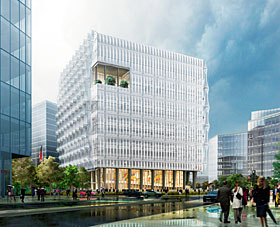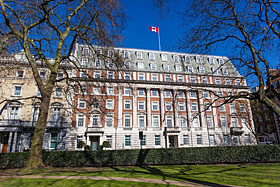Governments cashing in on the prime property locations of their embassies

Roula Khalaf, Editor of the FT, selects her favourite stories in this weekly newsletter.
Russian oligarchs and Chinese billionaires are among those who have benefited from London’s rocketing property prices. And with prices in the super-prime areas of Kensington, Mayfair and Belgravia at an all-time high, governments around the world are realising they are sitting on significant property assets: their embassies.
Often located in architecturally imposing period buildings, embassies are particularly attractive for conversion to housing. London’s long history as a global diplomatic centre means many of the biggest opportunities for developers lie in the most opportune – and expensive – parts of central London.
Research by Savills, the estate agents, suggests embassy properties across the city are worth as much as £1.4bn in total.
“Embassies move rarely and their locations are usually a function of historic legacy,” explains Charles Dugdale, a residential development partner at Knight Frank, the property consultancy. “As a byproduct of their often prestigious locations, there is a significant commercial incentive to relocate to a lower-value area.”
A study conducted last year by estate agents Wetherell found that a wave of sales of embassy and other diplomatic buildings could create hundreds of new homes in London’s most expensive neighbourhoods. Around 20 properties were up for sale in the first six months of 2013 alone, the firm found, the largest number being in Kensington followed by Mayfair, Marylebone and Holland Park. Grosvenor Square, Kensington Palace Gardens and Portland Place were particularly popular addresses.
Peter Wetherell, the firm’s managing director, says the expiry of long-term “peppercorn” rents granted by central London landlords, such as the Crown Estate and the Grosvenor Estate, was responsible.
“These highly advantageous leases have either expired or are coming to an end, and some of the diplomatic missions are, therefore, seeking new premises that will be more cost-effective to run, rather than paying commercial prices on their current properties,” he says.

The flagship move has been the sale of the US embassy in Grosvenor Square, one of London’s most desirable addresses, to Qatari Diar, the Middle Eastern sovereign wealth fund, and developer Chelsfield in 2009 for an undisclosed sum. They plan to convert the Grade II-listed modernist building, completed in 1960, into a mixed-use development, although details have yet to be announced. The US, meanwhile, is using the proceeds to fund its move south of the Thames, set for 2017, as part of the dramatic transformation of the previously rundown Nine Elms area.
Since that transaction, several more London embassies have cashed in on the city’s booming housing market. The former Kazakhstan embassy at Thurloe Square, South Kensington, is being converted by developer Northacre into luxury homes, with finance from Abu Dhabi Capital Management. The Dutch embassy is moving from its Hyde Park Gate home, which has been bought by Irish developer Ballymore, also to Nine Elms. China is also considering shifting its diplomats to Nine Elms, which would free up its Portland Place property.
And last autumn, Lodha, the Indian property company, bought the Canadian High Commission, formerly at 1 Grosvenor Square, Mayfair, seen as potentially one of London’s most exclusive addresses (see below), for £306m.

Properties that can be redeveloped will be most attractive to Asian buyers, who like modern homes with high-tech services, according to Henry Pryor, who acts as a buying agent for high-end London house purchasers. Meanwhile, converted properties appeal more to buyers from the Americas, he says. “As embassies relocate, it is interesting to see the value of what was, in diplomatic terms, a piece of Canadian or American soil jump as they become London real estate at London prices.”
The great embassy sell-off taps into a wider trend driving London property markets: the move from commercial to residential. The UK government changed the planning rules last May to make it easier to convert office buildings into homes. While this has been opposed by local politicians in Westminster – where many embassies are based – the flood of property conversions continues unabated.
As a result, while the UK capital is by far the largest market for embassy acquisitions, the trend is spreading around the world. Lodha, for example, purchased its first diplomatic property in 2012 when it acquired Washington House, the US consulate building in Mumbai.
Meanwhile, the French government has been cutting back on its diplomatic properties in recent years, selling its embassy building in Dublin last year. It has also reportedly sold an apartment in Berlin, the consular residence in Hong Kong and a plot in Kuwait City. And the Greek consul’s residence in London was sold off last year.
In addition, the requirements of the diplomatic corps are also shifting, making embassies, particularly those in historic buildings, obsolete.
“Embassies in the modern age now need to be efficient offices, rather than converted mansions,” says Dominic Grace, head of Savills’ London residential development team.
“Older buildings also tend to be more difficult to make secure – an increasingly important factor. Also, the long reach of most democracies’ fiscal beancounting now extends globally, so only countries that are awash with sovereign wealth can justify ‘trophy’ embassies, which often have millions of value tied up in them that could be better spent back home.”
——————————————-
Canada cashes in on Indian appetite

As an entry into the London property market, it was a dramatic move. The first UK acquisition by Lodha, the Indian property developer, was the Canadian High Commission at 1 Grosvenor Square, last November. The £306m purchase drew admiring gasps from the market and rapidly came to symbolise the strong appetite among developers for diplomatic property, driven by the great scope that embassy buildings offer for redevelopment.
The price was around 30 per cent higher than the property had been expected to sell for and as many as 80 bidders competed to acquire it, according to people with knowledge of the matter.
The attraction for most bidders was primarily the opportunity to convert the embassy into residential property. It “has the potential to be the best address in London”, according to Charles Dugdale of Knight Frank, who advised Lodha on the purchase.
Comments